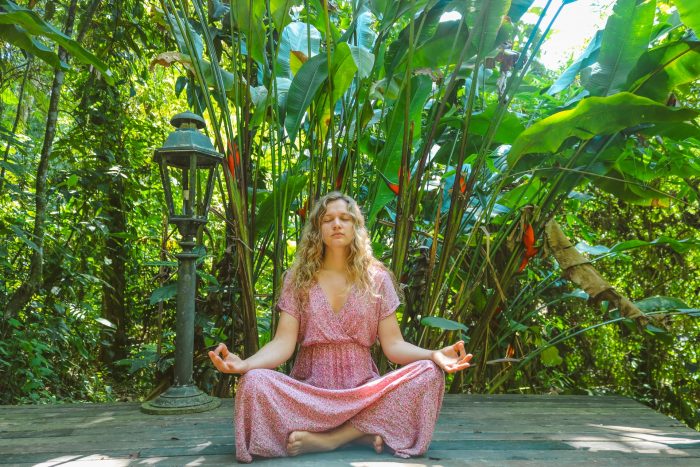The media abound with stories of how meditation will cure everything from high crime and low grades in challenged school districts to the common fear and anxiety we all struggle with.
It’s proven to improve your ability to concentrate and even aid in the healing of physical ailments.
You have likely seen cute pictures of elementary school kids in lotus pose in lieu of time-outs, and images of beautiful people with blissful yoga expressions might well lead you to believe that if only you could meditate, you too would experience instant bliss and higher awareness.
It’s easy to understand why it is thoroughly disappointing and downright disconcerting when all you experience when sitting in meditation is a nervous shortness of breath and a significant rise in anxiety.
If that’s happening to you when you practice meditation, you are not alone.
As a trainer of aspiring yoga teachers at Saint Paul College, I am a stickler about having them implement a meditation practice throughout the training, and the reports I am getting back from a number of students are not as rosy and excited as you might think.
In some cases, my students experienced such a severe increase in anxiety that they have to temporarily quit their practice, and they struggle to understand how a 20-minute practice can be so challenging.
Indeed, the single most difficult yoga teacher training program requirement for my students to implement is not the acrobatic poses like forearm stand or handstand—no; it is sitting down to do their daily meditation.
It takes much less time than the average asana practice, and with the right support, it’s not all that physically challenging (they are even told they can use a chair if necessary)—so why does the touted yogic meditation bliss elude a fair amount of students when they first embark on a meditation path?
My best answer is that meditation is in part the art of becoming quiet and attuned to what is truly happening in our inner environment, and in a culture where being extroverted and busy in the world is celebrated from an early age, chances are there has not been a lot of quiet introspection happening along the way.
So, whatever feelings and experiences have been stuffed into the back of the closet, so to speak, often for years, and years, and years, will suddenly become visible. When the water of the mind becomes still, you will suddenly see the old, gunky tires and all the other junk that you have stored at the bottom of the lake.
When the surface of the mind becomes still and the inner landscape becomes visible, it might well cause some sadness or even fear.
With a thought like, “What is wrong with me that I am not experiencing deep happiness from meditation?” it’s understandable that you might hurry up and try to ruffle the surface of the mind with a distraction of some kind.
In my teacher training program, a student once told me in exasperation, “Every time I sit down to meditate, all I want to do is watch Netflix instead!” So we started calling it “Netflixing”—which can indeed be Netflix and ice cream but might also be anything from drugs and alcohol to shopping and social media to something as innocent as engaging in outer chatter and busyness with other people instead of sitting in stillness with yourself.
Netflixing works—then you no longer have to deal with the awareness of what shadowy objects, experiences, habits, and emotions lay at the bottom of your mind lake—and all is seemingly well again.
Of course, the yogic path is to stay the course. Dive in. Inspect the old tire and address it, instead of ignoring that it’s there—because ignoring the presence of pain that is crying out for healing is ultimately a lot of work and presents its own set of problems.
Any kind of “Netflixing” designed to distract yourself from the presence of inner pain and discomfort will ultimately have its own detrimental effects on the body and mind.
What you can do when meditation is anything but blissful:
1. Seek Help.
If the anxiety that arises is overwhelming you, the wisest course of action is to seek professional help. I don’t think I know a single serious meditator who hasn’t gone through a significant amount of counseling. One student experienced such serious anxiety and nightmares after a sincere attempt at developing a meditation practice that she nearly dropped out of the program.
At that point, we have to realize that whatever “old tires” have become visible, they are just too big and scary for one little person to deal with. So get help but stay the course of clearing out the lake of your mind. Because once you know what’s down there, it will become all the harder and take all the more netflixing to keep it covered up.
2. Share your feelings.
If the anxiety is mild but definitely there, know that it’s normal. Speak up. Share your pain. You are not alone. All serious yogis have to go through this declutter work. It’s not comfortable but once you have taken the first steps, it’s a lot more work to stay stagnant than to move forward.
3. Meditate in groups.
Many meditation centers offer meditation sessions paired with sharing and discussions and other community-building activities. Here you might find more experienced meditators who will be happy to mentor you through the initial phases of finding your meditation groove.
4. Pray.
This is a loaded word, so let me just suggest that you try it out for size; find the inner trust that Spirit, The Divine, God is with you and that Divine Grace will help you through the rough patches. Surrender to the divine process of becoming free from the inner obstacles that are operating beyond your conscious awareness.
Ishvara Pranidhana is Sanskrit for complete surrender to the Divine Will. When meditation becomes painful for me, I shift my intention from sitting with what is, to praying to transform what hurts. I pray for help. Just like that. Help me! Please help me! I feel small and inadequate and what I am feeling is overwhelming and sad. Please help me…
5. Netflix.
Whatever that means for you. Step away from the meditation cushion. Soothe yourself. It’s okay. You are hurting and it’s too much. Go to bed with Netflix or go out to a party. You have the choice not to feel this anymore today. But come back to it again when you feel a bit stronger.
In my early days with Tibetan Buddhist meditation in the late 80s, I remember hearing something to this effect:
“Before enlightenment, meditate to find out who you are. After enlightenment, meditate because you know what you are.”
If I had known 26 years ago that at age 45, I would still be in the process of finding out who I am, I might have given up. But here I am, still at it. Some days, meditation is a truly blissful experience of oneness; every cell in my body sings with joy and aliveness and beauty radiates back at me everywhere I look. I rest in the sea of pure awareness and my body seems completely porous and the world around me is inside of me.
Other days, I tremble and suffer. My gut is fraught with anxiety. My loneliness is profound and emotional pain nearly chokes me. I want to scream and run away.
Sometimes I do. I do my version of netflixing; I eat sweets and I immerse myself in other people’s problems so I don’t have to feel my own; then I see a somatic experience practitioner who makes me feel my pain even more deeply, so I can release it.
And then I meditate again.
~












Read 4 comments and reply